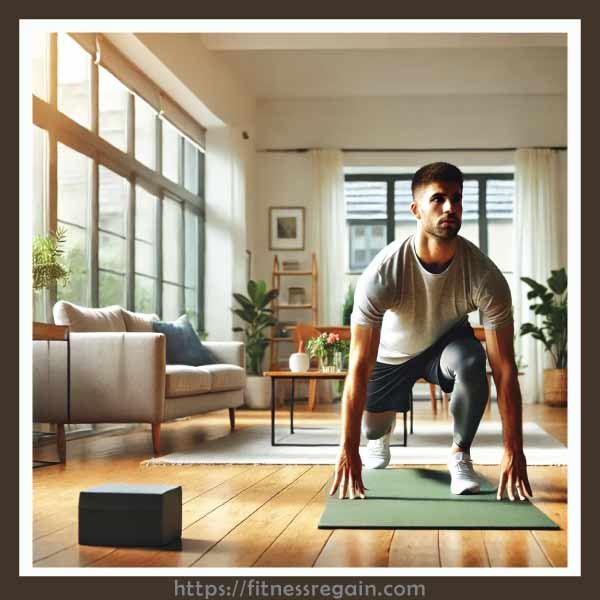In today’s fast-paced world, finding time to hit the gym can be a challenge. However, staying fit doesn’t always require fancy equipment or a gym membership. With the right approach, you can achieve your fitness goals from the comfort of your own home, using nothing but your body weight and a bit of creativity. Whether you’re a beginner looking to kickstart your fitness journey or a seasoned athlete seeking new challenges, home workouts without equipment offer a versatile and effective way to stay in shape. Let’s dive into how you can get started!
Benefits of Home Workouts Without Equipment
Before we delve into the exercises, let’s explore why home workouts without equipment are worth considering:
- Convenience: You can exercise anytime, anywhere, without the need to commute to a gym.
- Cost-Effective: No expensive gym memberships or equipment purchases required.
- Versatility: From strength training to cardio and flexibility exercises, you can create a well-rounded workout routine.
- Privacy: Enjoy exercising in the comfort and privacy of your own space.
Getting Started: Setting Up Your Home Workout Space
Creating a dedicated workout area within your home can help you stay motivated and focused. Here are a few tips to set up your home workout space:
- Clear Space: Choose an area with enough room to move freely without obstacles.
- Comfortable Flooring: Opt for a non-slip surface like yoga mats or carpet to prevent injuries.
- Good Ventilation: Ensure proper airflow to stay comfortable during your workouts.
- Natural Light: If possible, exercise in a space with natural light to boost your mood.
Also Read:
Wall Pilates Exercises for Senior: A Complete Guide
Warm-Up and Cool Down: Essential Preparations
Before diving into your workout, it’s crucial to warm up your muscles and prepare your body for exercise. A proper warm-up increases blood flow, improves flexibility, and reduces the risk of injury. Here’s a simple warm-up routine you can follow:
- March in Place: 1-2 minutes of marching in place to elevate your heart rate.
- Arm Circles: 1 minute of arm circles (both forward and backward) to loosen up your upper body.
- Leg Swings: 1 minute of leg swings (front to back and side to side) to warm up your lower body.
After completing your workout, don’t forget to cool down with gentle stretches to promote muscle recovery and flexibility. Spend 5-10 minutes stretching major muscle groups, such as your hamstrings, quadriceps, calves, chest, and shoulders.
🏠 Video Guide: How to Do Home Workouts Without Equipment
Watch this beginner-friendly YouTube video to learn how to do home workouts without any equipment. Build strength, burn calories, and stay fit using just your bodyweight at home.
Full-Body Workouts: Exercises You Can Do Anywhere
Now, let’s explore a variety of exercises that target different muscle groups. Perform each exercise for 12-15 repetitions (reps) or 30-60 seconds, depending on your fitness level. Aim for 2-3 sets of each exercise with a brief rest between sets. Modify the intensity by adjusting your speed, range of motion, or adding pauses.
Upper Body Exercises
- Push-Ups: Targets chest, shoulders, and triceps.
- Tricep Dips: Targets triceps and shoulders using a stable surface like a chair.
- Plank: Engages core muscles, shoulders, and back for stability.
- Arm Circles: Enhances shoulder mobility and strengthens arm muscles.
Lower Body Exercises
- Bodyweight Squats: Targets quadriceps, hamstrings, and glutes.
- Lunges: Strengthens quadriceps, hamstrings, and glutes.
- Calf Raises: Builds calf muscles for stability and strength.
- Wall Sit: Engages quadriceps, hamstrings, and glutes for endurance.
Core Exercises
- Crunches: Targets upper and lower abdominal muscles.
- Leg Raises: Engages lower abdominal muscles and hip flexors.
- Bicycle Crunches: Works oblique muscles and enhances core strength.
- Plank Variations: Side planks, plank with leg lifts, and forearm plank to challenge core stability.
Cardiovascular Exercises
- Jumping Jacks: Improves cardiovascular endurance and coordination.
- High Knees: Boosts heart rate and engages leg muscles.
- Burpees: Combines strength and cardio for a full-body workout.
- Mountain Climbers: Targets core muscles and enhances agility.
Also Read:
🏠 Video Guide: How to Do Home Workouts Without Equipment
Watch this beginner-friendly YouTube video to learn how to do home workouts without any equipment. Build strength, burn calories, and stay fit using just your bodyweight at home.
Creating Your Workout Routine
To maximize your results, create a balanced workout routine that includes exercises from each category. Start with a 5-10 minute warm-up, followed by 20-30 minutes of strength, cardio, and core exercises. Cool down with stretching exercises to improve flexibility and reduce muscle soreness.
Progression and Variations
As you become more comfortable with your workout routine, challenge yourself by increasing the number of repetitions, sets, or duration of each exercise. Incorporate variations such as adding weights (like water bottles or household items), adjusting tempo, or trying advanced variations of bodyweight exercises.
Conclusion
Home workouts without equipment offer a convenient and effective way to achieve your fitness goals without the need for a gym. By incorporating a variety of exercises targeting different muscle groups, you can create a versatile workout routine that keeps you motivated and challenged. Remember to listen to your body, stay hydrated, and consult a healthcare professional before starting any new exercise program, especially if you have pre-existing health conditions.
Start your fitness journey today with these simple yet powerful exercises, and enjoy the benefits of a healthier, stronger you right from the comfort of your own home!
Also Read:
Wall Pilates for Core Strength: The Ultimate Guide
FAQs On How to Do Home Workouts Without Equipment:
Can I build muscle with home workouts without equipment?
Yes, you can build muscle using bodyweight exercises like push-ups, squats, and lunges. Progressive overload, such as increasing reps, sets, or intensity, helps muscle growth. Incorporate variations like plyometrics and isometric holds to challenge muscles and achieve strength gains over time.
How often should I do home workouts without equipment?
For balanced fitness, aim for at least 4-5 days per week. Include strength training, cardio, and flexibility exercises. Allow muscle recovery by alternating workout intensity or targeting different muscle groups. Consistency and proper rest are essential for effective progress and preventing injuries.
What are the best full-body exercises for home workouts?
The best full-body exercises include push-ups, squats, burpees, lunges, planks, and mountain climbers. These movements engage multiple muscle groups, improve endurance, and enhance overall fitness. Combining strength and cardio exercises ensures an effective, well-rounded workout routine without any equipment.
How can I make home workouts more challenging?
To increase difficulty, try advanced variations, increase reps, slow down movements, or add explosive exercises like jump squats. Isometric holds and supersets can enhance intensity. Using household items like water bottles for resistance can also make workouts more challenging.
Can home workouts help with weight loss?
Yes, home workouts help with weight loss by burning calories and improving metabolism. High-intensity exercises like jumping jacks, burpees, and high knees elevate heart rate, while strength training builds muscle, boosting fat loss. A balanced diet and consistent workouts maximize results.


Can I do This in my home ?